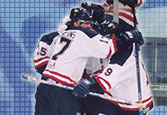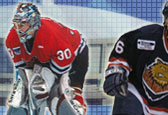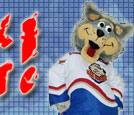For the second straight year, the National Hockey League invites fans to celebrate the diversity of the game during �Hockey is for Everyone� Month in February.
Each year, Member Clubs in the NHL, American Hockey League, ECHL, Central Hockey League and United Hockey League highlight the growth of the game of hockey during �Hockey is for Everyone� Month. This year�s celebration begins during the 2004 NHL All-Star Week on Feb. 3-8 in Minnesota and will culminate with the Ninth Annual Willie O�Ree All-Star Weekend, Feb. 28-29 in Anaheim, Calif. The Willie O�Ree All-Star Weekend is named for the NHL�s first black player and current director of youth development, and will feature 24 outstanding young people representing grass-roots hockey organizations across North America.
By Ursula Liang
If they were on the same team, playing the same line, they�d be a deadly offensive force: a perennial National Hockey League All-Star and U.S. Olympian, a two-time Stanley Cup Champion and Calder Trophy winner, a high energy, gritty power forward with a deadly shot. But Bill Gueren, Scott Gomez and Raffi Torres come from vastly different places and experiences, not to mention teams. Yet their collective success is scoring big-time points and inciting growth within a culture not usually synonymous with the sport of hockey.
Bill Guerin: The Trailblazer
Seventy-two inches of rain pounded the pavement and soaked the ground. Mudslides buried villages. It was 1998 and Bill Guerin was an Edmonton Oilers forward at 27 years old, seven years into his NHL career, when Hurricane Mitch ravaged Nicaragua, his mother�s homeland. Guerin couldn�t stop the rain. He couldn�t save the tens of thousands who died. What he could do was lead the recovery.
So, he leveraged his celebrity and helped the Red Cross raise a quarter-million dollars in Edmonton for the Hurricane Mitch relief efforts. More than a statistical and cultural anomaly, beyond the plus/minus, the right wing was an icon for Central Americans in a time of tragedy.
But few knew that Guerin�s interest in the relief efforts was also personal. Even fewer knew that the shy and private Guerin was Nicaraguan and Irish-American, possibly making him the first Latino in the NHL.
Scott Gomez: The Latino Hockey Star
A year after Hurricane Mitch hit Nicaragua, another Latino hockey player arrived in the league with as much whirlwind. With his heritage emblazoned across his sweater, Scott Gomez, the son of a Mexican American construction worker and a Colombian American homemaker became an identifiable torch bearer for Latinos on ice. And by virtue of his surname, the center was charged with the responsibility of being a pioneer as he skated to instantaneous success and fame with the New Jersey Devils, capturing an NHL All-Star appearance and a Stanley Cup championship.
So Gomez was labeled the trailblazer, inspiring the Latino community and a new generation of hockey players. And Guerin remained silent but proud.
�People don�t assume I am Hispanic, because my last name is Irish,� Guerin explains. �I thought it was great when I heard that Gomer was coming into the league. He�s got the name, he�s got the looks, and all the attention he gets is great for hockey.�
�Guerin always gives me crap [about getting so much attention for being a Latino in the NHL]� says Gomez. �He says I steal his thunder.�
�It�s all in fun,� explains Guerin, now with the Dallas Stars.
Media swarmed Gomez, fans accumulated in huge numbers, kids
worshipped and followed. The rookie-of-the-year from the most unlikely of backgrounds gave promise to a new brand of hockey fan.
�Latinos are definitely proud of their own,� says Gomez. �A couple of guys came up to me almost in tears to tell me how proud they were. That hits the heart.�
And then there were three.
Raffi Torres: A Bright Young Star
Raffi Torres completed the NHL Latino trifecta in 2001, when he took to the ice for the New York Islanders. With his red hair and light eyes, Canadian-born Torres, now with the Oilers, may look least like a beacon for Latinos, but his Mexican and Peruvian heritage (tattooed to his body in the form of a Mexican flag) has not been lost on aspiring hockey families.
�I get a lot of fan mail from Latino parents who want to know how my parents handled my hockey training,� the left wing says. �They wonder if it�s worth the struggle, and I always tell them it is.�
Despite their success in inspiring Latinos in hockey, neither Gomez, Torres nor Guerin will take credit for their groundbreaking roles.
�It�s hard for me to think of myself as a pioneer,� Gomez says. �That�s a title you reserve for players like Jackie Robinson and Willie O�Ree -- people who struggled throughout their lives to pave the road for future generations.�
Gomez, Guerin and Torres say hockey was an extension of their everyday lives growing up in hockey-dominated, cold-weather climates (Anchorage, Alaska, Wilbraham, Mass. and Toronto, Ont. respectively). They were blessed with supportive, stable families and surrounded by friends and neighbors who lived and breathed hockey.
�My little cousins are getting into hockey and it�s different for them,� Torres says. �I was born in Canada, but they�ve come straight from Lima, Peru. They don�t speak English and that makes things really difficult. But they see me playing on TV and they love the game. It�s amazing to see how they�re progressing. That will be the generation that really breaks through.�
Future Hockey�s Hot Beds
In barrios where soccer and baseball dominate, hockey is still struggling to find its place. But with three Latinos in the NHL and through the NHL�s diversity initiatives and blossoming learn-to-skate programs across the globe, the sport is ripe for enormous growth. Recent marketing studies indicate that Latino-Americans are beginning to identify more strongly with mainstream American sports like football and hockey than with soccer.
�We just need to hold more hockey events in the neighborhoods where kids who don�t know the sport can learn the rules of the game and how to hold a stick properly,� says Torres.
�My mother and I learned hockey together,� Guerin says. �She didn�t know anything about the game, but wanted me to skate to have something to do in the winter. And now she�s a huge fan.�
According to the 2000 U.S. Census, Latinos account for well over 12.5% of the U.S. population and have the second fastest growth rate among American racial groups. Hockey�s growth within the Latino community will be contingent upon continued and increased resources and opportunities.
Such is the case in Mexico, where NHL Diversity and L�EntrePot Hockey-Quebec have helped secure equipment and training for Mexicans with fewer resources.
�It is just a question of inviting people to participate and share the excitement,� says Joseph Bartell, Director of Hockey Programs in Puebla, Mexico. �Mexican people are very friendly and love sports.�
Bartell began teaching hockey in Puebla, Mexico in 1995, when he happened upon a rink as a university exchange student.
�A friend saw me wearing a hockey shirt from my college team and told me that there was a rink in Puebla,� he remembers. I didn�t believe it but I went and checked it out and there really was a rink and a hockey program!�
Now the Director of Hockey programs for the City of Puebla, Bartell has partnered up with a neighboring rink to offer learn-to-skate programs, recreational skating and an adult league for more than 200 Mexicans. According to Bartell, Mexico is now seen as one of the most impressive areas of ice hockey growth in Latin America, sending players to Canada to train and dismantling stereotypes that had been associated with the sport.
�Every once in a while a scout will tell me about a talented Mexican player he�s seen,� says Gomez.
�Latin American countries are about 10 to 15 years behind in ice hockey development,� says Gordon Young, the referee-in-chief for the Federation International De Roller Sports, who travels the globe to promote and referee inline and ice hockey. �But I�m often surprised at how much Latinos know about hockey.�
When he decided to pop in an outdated NHL highlight tape to give a group of Latinos a basic feel for the game while he was setting up for a hockey clinic, they quickly set him straight.
�The one kid in the group who knew a lot of English piped up and said �Don�t you have anything more modern than this? We�ve seen all these games on satellite TV.��
Hockey programs, Spanish-language programming, and global culture have contributed to the progress of a sport that once seemed incongruous with warmer climates and poorer economies. According to Young, Latin Americans don�t just root for the NHL�s three Latino standouts, but they count players like Wayne Gretzky, Paul Kariya, Teemu Selanne, and Eric Lindros among their heroes. All of the teams in the NHL are popular, including the New Jersey Devils, Mighty Ducks of Anaheim, Dallas Stars, Los Angeles Kings, Montreal Canadiens and Toronto Leafs. From time to time, Young says he occasionally finds copies of The Hockey News at newsstands during his travels.
The popularity of inline hockey in Latin American countries has also helped immensely. Jack Caine, the founder and president of the Asociacion Deportiva Hockey in Costa Rica, says inline hockey participation on a league level has increased from 30 players to 500 in the past four years. California was able to translate the popularity of inline skating into support for ice hockey programs and teams, and Latin American countries believe they can do the same.
Dave Wilk, who founded the Ice Hockey In Harlem program in New York City and now oversees California-based Disney GOALS, is benefiting from the success the NHL has had in developing interest in hockey in California. With funding from Disney and support from the Mighty Ducks of Anaheim and NHL Diversity, Disney GOALS, which offers disadvantaged children educational and hockey instruction, has graduated more than 17 of its players to top collegiate hockey programs. More than 2,000 boys and girls, mostly Latino, participated in the Disney GOALS program in 2003.
According to Trey Medlock, the General Manager of the AA Rio Grande Killer Bees in the Central Hockey League, the team�s first year of existence has subsisted on the patronage of Latinos. Medlock states that more than 50% of the fans at Killer Bees games are Latinos, 75% of the people who attend public skating after games are Latino, and 40% of the Killer Bee Foundation Outback Steakhouse Junior hockey players are Latino. The Bees have broadcast all of their games across the Mexican-U.S. border on the radio and about 40% of their games on Mexican television. And while some are just beginning to understand the potential of Latino fans and player, the Bees have already seen its fruits. �Once people get a taste of hockey, they want to come back,� Medlock says.
Although hockey is still on the rise amongst Latinos, and challenges remain before the community as a whole is endeared to this burgeoning sport, Gomez, Guerin and Torres are pleased to help lead the cause.
�It�s an honor to help open doors for Latinos,� Says Gomez �I am proud of who I am and I�d love to see another Gomez in the NHL soon.� With luck, and continued dedication from those working to develop ice hockey in Latin America and amongst Latino Americans, there might just be another Gomez, Guerin or Torres in the NHL very soon. And maybe they�ll play on the same line.
Ursula Liang is a freelance writer and a frequent contributor to ESPN The Magazine. She currently resides in New York City.
|





